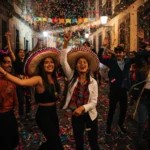Canang: A Daily Offering of Gratitude
Canang sari, often simply called “canang,” are small, intricately woven palm leaf trays filled with colorful flowers, incense, and sometimes food offerings. You’ll see them everywhere in Bali, from temples and homes to shops and sidewalks. These offerings are not just decorative; they’re a fundamental part of Balinese Hindu culture, a daily expression of gratitude to the gods and a way to maintain spiritual balance.
Making and placing canang is a sacred act performed by Balinese people of all ages, usually multiple times a day. Each morning, you’ll witness locals meticulously crafting these offerings, their hands moving with practiced grace. The air fills with the scent of incense as the canang are placed on shrines, doorways, and even on the ground as a symbol of devotion.
As a traveler, you’re welcome to observe this beautiful ritual, but remember to be respectful. Avoid stepping on or disturbing canang, and if you’re interested in learning more, consider joining a canang-making workshop to experience this cultural tradition firsthand.
Symbolism: The Essence of Every Element
Every element in a canang holds symbolic meaning. The base, woven from palm leaf, represents the earth and the natural world. The colorful flowers, often meticulously arranged, are symbols of beauty, purity, and the divine feminine energy. Incense sticks, releasing fragrant smoke, carry prayers and intentions upwards to the heavens.
Food offerings, such as rice cakes or fruits, are gestures of gratitude for abundance and sustenance. Even the colors of the flowers have significance, with white symbolizing purity, red representing bravery, and yellow signifying creativity. Each canang is a microcosm of the Balinese worldview, a harmonious blend of nature, spirituality, and everyday life.
Understanding the symbolism behind each element deepens your appreciation for this cultural practice. It’s a reminder that even the smallest details in Balinese life are imbued with spiritual significance. As you encounter canang on your journey, take a moment to reflect on the intricate layers of meaning woven into each offering.
Gathering Materials: Nature’s Sacred Gifts
Creating canang is a deeply connected experience with the natural world. Many of the materials used are sourced directly from the surrounding environment. Palm leaves are carefully harvested and expertly woven into the base trays. Flowers are plucked from gardens and fields, their vibrant colors and delicate scents adding to the beauty of the offering.
Incense sticks are often made from local herbs and spices, their fragrance filling the air with a sense of tranquility. Even the food offerings, like rice or fruits, are a reminder of the land’s bounty. This connection to nature is a core aspect of Balinese Hinduism, where the environment is seen as sacred and deserving of reverence.
As you explore Bali, you might come across locals gathering these natural treasures for their canang. It’s a testament to the island’s deep-rooted respect for the environment and the interconnectedness of spirituality and nature. If you’re lucky, you might even be invited to participate in this gathering process, a unique opportunity to connect with the land and its traditions.
The Art of Assembly: A Step-by-Step Guide
Creating a canang is a delicate art that combines precision and creativity. The process begins with folding and weaving palm leaves into the base tray, a skill that takes practice to master. Next, the offerings are carefully arranged, starting with the base layer of rice or other grains, symbolizing abundance and prosperity.
Colorful flower petals are then meticulously placed, often in specific patterns or designs. Some canang feature intricate geometric shapes, while others showcase a more free-flowing, artistic style. Incense sticks are positioned strategically, their fragrant smoke meant to carry prayers upwards.
The final touch is often a sprinkle of holy water, a symbolic gesture that infuses the offering with divine energy. While the basic structure of a canang remains consistent, each one is unique, reflecting the individual’s personal expression and devotion. Witnessing this artful process is a mesmerizing experience, a testament to the Balinese people’s creativity and spiritual connection.
Beyond Flowers: Types of Canang Offerings
While the image of colorful flowers might be the most common association with canang, there’s actually a wide variety of these offerings, each with its own purpose and significance. Canang sari, as mentioned earlier, are the most common type, used for daily offerings of gratitude.
Canang genten, on the other hand, are larger and more elaborate, often used for special occasions or ceremonies. They may include additional offerings such as fruits, sweets, or even small statues representing deities. Canang ceper are smaller, simpler offerings, often placed on the ground or at crossroads.
Each type of canang carries its own symbolism and purpose, reflecting the diversity of Balinese Hindu traditions. As you explore the island, you’ll encounter this fascinating array of offerings, each a testament to the richness and complexity of Balinese spirituality.
Where to Learn: Hands-On Workshops in Bali
Interested in learning the art of canang making? Bali offers numerous workshops and classes where you can immerse yourself in this cultural tradition. Led by experienced local artisans, these workshops provide a hands-on opportunity to learn the intricate techniques of weaving palm leaves, arranging flowers, and understanding the symbolism behind each element.
Many workshops are held in serene settings like traditional Balinese homes or community centers, allowing you to connect with the local culture and its people. Some even include visits to temples or markets to gather materials, offering a deeper understanding of the entire process.
These workshops are not only educational but also a fun and interactive way to experience Balinese culture. You’ll leave with not only a beautiful canang of your own creation but also a newfound appreciation for this ancient tradition and the people who keep it alive.
Canang Etiquette: Respecting Local Traditions
While canang are a beautiful and fascinating aspect of Balinese culture, it’s important to remember that they are sacred offerings with deep spiritual significance. As a visitor, it’s essential to show respect and avoid any actions that might be considered disrespectful.
Firstly, never step on or disturb canang. They are placed intentionally and should be treated with reverence. If you accidentally touch one, apologize sincerely, as it’s considered disrespectful to disturb an offering.
Secondly, avoid wearing revealing clothing when visiting temples or participating in canang-making activities. Bali is a conservative island, and dressing modestly is a sign of respect for local customs.
Finally, be mindful of your photography. While it’s natural to want to capture the beauty of canang, avoid getting too close or interrupting rituals. Ask for permission before taking photos of people making or placing offerings.
Spiritual Significance: More Than Meets the Eye
Canang are not merely decorative objects; they hold profound spiritual significance in Balinese Hinduism. They are seen as a way to maintain balance in the universe, appeasing both benevolent and malevolent spirits.
Each canang is a gesture of gratitude to the gods, a way to acknowledge their presence and seek their blessings. The act of making and placing canang is a form of meditation, a way to connect with the divine and cultivate inner peace.
For the Balinese people, canang are an integral part of daily life, a constant reminder of their spiritual connection to the world around them. Witnessing this deep devotion is a humbling experience, offering a glimpse into the heart of Balinese culture.
Offerings Beyond Canang: Exploring Variety
While canang are the most common type of offering in Bali, they are not the only ones. The island is rich in diverse rituals and traditions, each with its own unique offerings.
For example, you might encounter gebogan, large, towering structures made of fruits and flowers, often used in temple ceremonies. Sesajen are elaborate offerings placed on altars or shrines, often consisting of multiple layers of food, flowers, and other symbolic items.
Banten are smaller, individual offerings often placed at specific locations like crossroads or near rivers. Each of these offerings serves a specific purpose, reflecting the complexity and diversity of Balinese Hindu rituals.
Canang & Tourism: Mindful Cultural Exchange
As tourism in Bali has grown, so too has interest in canang and other cultural traditions. Many visitors are drawn to the beauty and spiritual significance of these offerings, eager to learn more and even participate in their creation.
This cultural exchange can be a positive experience, fostering understanding and appreciation between different cultures. However, it’s important for both tourists and locals to approach this exchange with mindfulness and respect.
Tourists should be aware of the sacred nature of canang and avoid treating them as mere souvenirs or photo opportunities. Locals, on the other hand, should be open to sharing their traditions in a way that is both educational and respectful of their cultural heritage.
Photography Tips: Capturing Canang Respectfully
If you’re a photography enthusiast, Bali offers endless opportunities to capture stunning images of canang and other cultural offerings. However, it’s crucial to approach this with sensitivity and respect.
Firstly, always ask for permission before taking photos of people making or placing offerings. It’s a simple gesture of courtesy that goes a long way in building trust and understanding.
Secondly, avoid using flash photography, especially in temples or during ceremonies. The bright light can be disruptive and disrespectful to the sacred atmosphere.
Finally, be mindful of your composition. Try to capture the essence of the offering, its symbolism, and the devotion of the people who created it. Avoid focusing solely on the aesthetic aspect and strive to convey the deeper meaning behind each canang.
Canang Resources: Further Learning & Inspiration
If you’re eager to learn more about canang and Balinese culture, there are numerous resources available to deepen your understanding.
Many books and articles delve into the history, symbolism, and significance of these offerings, providing valuable insights into this fascinating tradition.
You can also find online tutorials and videos that demonstrate the step-by-step process of canang making, allowing you to practice and refine your skills even after your trip.
Additionally, consider visiting local museums and cultural centers that showcase Balinese art and artifacts, offering a broader context for understanding the cultural significance of canang.











